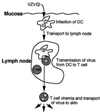Varicella zoster virus immune evasion strategies
- PMID: 20563710
- PMCID: PMC3936337
- DOI: 10.1007/82_2010_41
Varicella zoster virus immune evasion strategies
Abstract
The capacity of varicella zoster virus (VZV) to cause varicella (chickenpox) relies upon multiple steps, beginning with inoculation of the host at mucosal sites with infectious virus in respiratory droplets. Despite the presence of a powerful immune defense system, this virus is able to disseminate from the site of initial infection to multiple sites, resulting in the emergence of distinctive cutaneous vesiculopustular lesions. Most recently, it has been proposed that the steps leading to cutaneous infection include VZV infecting human tonsillar CD4(+) T cells that express skin homing markers that allow them to transport VZV directly from the lymph node to the skin during the primary viremia. It has also been proposed that dendritic cells (DC) of the respiratory mucosa may be among the first cells to encounter VZV and these cells may transport virus to the draining lymph node. These various virus-host cell interactions would all need to occur in the face of an intact host immune response for the virus to successfully cause disease. Significantly, following primary exposure to VZV, there is a prolonged incubation period before emergence of skin lesions, during which time the adaptive immune response is delayed. For these reasons, it has been proposed that VZV must encode functions which benefit the virus by evading the immune response. This chapter will review the diverse array of immunomodulatory mechanisms identified to date that VZV has evolved to at least transiently limit immune recognition.
Figures


References
Publication types
MeSH terms
Grants and funding
LinkOut - more resources
Full Text Sources
Medical
Research Materials

